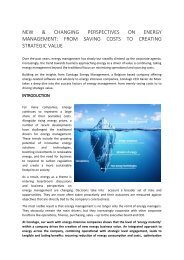Accurate Allocation of energy in production processes - the importance of using metamodels
Many companies struggle with correctly monitoring, allocating and distributing direct and indirect energy consumption over all internal and external customers, users or products. In this age of rising commodity costs and additional attention to sustainability, the advantages of adequately allocating energy are nonetheless substantial: 1. Real-time mapping of energy throughout process flows makes it easier to detect deviations in energy conversions during production processes, find the root causes and reduce losses. 2. Using exact and objective keys for allocating energy consumption speeds up periodic P&L and CSR reporting and makes for more accurate reports. 3. Continuous, real-time distribution of energy cost among users increases transparency and raises awareness with them. Although most companies already struggle with integrating correct data from metered equipment, this is only the first - albeit important - step. The crux is fully understanding the nature and efficiency of energy conversions processes; energy inflows and outflows to different customers; fixed and variable costs and corporate structures. By using metamodels - designed for and maintained by energy managers - all this information is added to the initial metered data and processed in such a way that any change from an energy point of view instantly leads to adjustments in the energy allocation. This white paper reviews emerging trends and challenges in energy allocation and examines the working and benefits of using specific metamodels at the level of energy management software.
Many companies struggle with correctly monitoring, allocating and distributing
direct and indirect energy consumption over all internal and external customers,
users or products. In this age of rising commodity costs and additional
attention to sustainability, the advantages of adequately allocating energy are
nonetheless substantial:
1. Real-time mapping of energy throughout process flows makes it easier
to detect deviations in energy conversions during production processes,
find the root causes and reduce losses.
2. Using exact and objective keys for allocating energy consumption
speeds up periodic P&L and CSR reporting and makes for more accurate
reports.
3. Continuous, real-time distribution of energy cost among users increases
transparency and raises awareness with them.
Although most companies already struggle with integrating correct data from
metered equipment, this is only the first - albeit important - step. The crux is
fully understanding the nature and efficiency of energy conversions processes;
energy inflows and outflows to different customers; fixed and variable costs
and corporate structures. By using metamodels - designed for and maintained
by energy managers - all this information is added to the initial metered data
and processed in such a way that any change from an energy point of view
instantly leads to adjustments in the energy allocation.
This white paper reviews emerging trends and challenges in energy allocation
and examines the working and benefits of using specific metamodels at the
level of energy management software.
Create successful ePaper yourself
Turn your PDF publications into a flip-book with our unique Google optimized e-Paper software.
This section presents a concrete metamodel and uses it to illustrate how<br />
<strong>metamodels</strong> work, what <strong>in</strong>telligence <strong>the</strong>y embody and how much complexity<br />
<strong>the</strong>y capture.<br />
A model for accurate distribution keys<br />
The goal <strong>of</strong> this model is to provide an accurate distribution key for all<br />
commodity types present on <strong>the</strong> site <strong>of</strong> a company, especially when on-site<br />
conversions come <strong>in</strong>to play.<br />
We will refer to <strong>the</strong> example given below <strong>of</strong> <strong>the</strong> CHP and hot water conversions<br />
to expla<strong>in</strong> <strong>the</strong> model (See figure 4).<br />
Example graph based model with CHP and hot water conversions<br />
Source node<br />
Electricity grid<br />
connection<br />
Distribution node<br />
Electricity<br />
S<strong>in</strong>k node<br />
Build<strong>in</strong>g product<br />
l<strong>in</strong>e 1<br />
Source node<br />
W<strong>in</strong>d turb<strong>in</strong>e<br />
Conversion node<br />
Comb<strong>in</strong>ed heat<br />
power<br />
S<strong>in</strong>k node<br />
Build<strong>in</strong>g product<br />
l<strong>in</strong>e 2<br />
Source node<br />
Natural gas grid<br />
connection<br />
Distribution node<br />
Natural gas<br />
Conversion node<br />
Hot water boilers<br />
Conversion node<br />
Hot water<br />
Source node<br />
Water grid<br />
connection<br />
Distribution node<br />
Water<br />
S<strong>in</strong>k node<br />
Build<strong>in</strong>g product<br />
l<strong>in</strong>e 3<br />
Figure 4: Graph-based model example.<br />
The model requires three steps to achieve correct distribution <strong>of</strong> <strong>the</strong> commodities<br />
(<strong>the</strong> source nodes) to <strong>the</strong> customers (<strong>the</strong> s<strong>in</strong>k nodes).<br />
1. Partition<strong>in</strong>g source node flows over distribution nodes<br />
The first step distribute <strong>the</strong> consumption <strong>of</strong> each commodity<br />
(represented by <strong>the</strong> source nodes) over its direct customers<br />
(represented by <strong>the</strong> distribution nodes). This <strong>in</strong>itial partition is<br />
based on submeter read<strong>in</strong>gs for all customers <strong>of</strong> <strong>the</strong> particular<br />
commodity type (represented by <strong>the</strong> s<strong>in</strong>k and conversion nodes).<br />
In <strong>the</strong> graph model above <strong>the</strong> total commodity consumption<br />
equals <strong>the</strong> sum <strong>of</strong> all <strong>the</strong> <strong>in</strong>put flows <strong>of</strong> a distribution node.<br />
Total water consumption (a distribution node), for example, is<br />
what is provided through <strong>the</strong> water network (a source node).<br />
18




